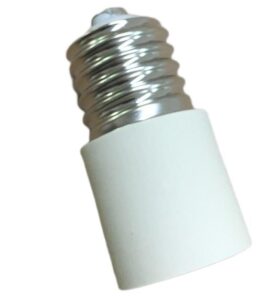When it comes to putting together light bulbs, every part is important to make sure they work safely, well, and last a long time. One of the most important parts is the base of the bulb. The base is how the bulb connects to the socket and the electrical circuit. A lot of bulbs have metal or plastic bases, but high-performance bulbs often have ceramic bases. Why is that? Understanding the benefits of ceramic bases in bulbs will help you understand why it’s used in demanding lighting situations.
The base of the bulb is made of ceramic because it can handle high temperatures, it provides great electrical insulation, and it’s really strong, which makes it safe and gives you a long-lasting bulb.
Now, let’s talk about why they use ceramic in light bulb bases and how it makes your lighting system work better and be safer.

Heat Resistance: A Key Reason for Ceramic Bases
One of the primary reasons why ceramic is used in bulb bases is its outstanding heat resistance. Light bulbs, particularly those with higher wattages or certain types like halogen bulbs, generate significant amounts of heat during operation. This heat is often concentrated at the base of the bulb where the electrical connections are made, which can cause problems for materials that cannot tolerate high temperatures.
Ceramic is an inorganic, non-metallic material that has an incredibly high melting point, making it an ideal choice for applications where heat resistance is critical. While materials like plastic may warp, melt, or degrade when exposed to heat over long periods, ceramic maintains its structural integrity. This heat resistance ensures that the base of the bulb doesn’t deform or compromise the electrical connections, even after extended use in high-heat environments.
In contrast, plastic bases are more likely to melt or crack under high heat, and metal bases, though durable, may conduct heat too efficiently, causing the fixture or socket to overheat. The heat tolerance of ceramic makes it particularly important in lighting applications that involve prolonged use, such as industrial settings, kitchen lighting, or enclosed fixtures, where heat can build up over time.

Electrical Insulation Properties
In addition to its impressive heat resistance, ceramic also excels as an electrical insulator, which is another key reason it is commonly used for bulb bases. Electrical insulation is critical for preventing electric shocks and short circuits. Since ceramic is a poor conductor of electricity, it effectively isolates the electrical components inside the bulb from external contact, helping to protect users and prevent malfunctions.
Bulbs with ceramic bases offer superior safety by ensuring that the electrical current stays confined to the designated path within the bulb, rather than leaking into the fixture or potentially causing an electric shock. This is particularly important when handling bulbs or changing them while the socket is still connected to a power source.
Ceramic’s natural insulating properties make it far safer than metal bases, which conduct electricity and could pose a risk of shock if improperly handled. In environments where safety is a top concern—such as in outdoor lighting or bathroom fixtures—the insulating qualities of ceramic make it the ideal material for bulb bases.
Durability and Longevity
Beyond its heat resistance and electrical insulation properties, ceramic is also known for its durability and long lifespan. It resists wear and tear better than plastic lamp bases, which can degrade over time due to repeated exposure to heat, moisture, or corrosion. This durability ensures that ceramic-based bulbs last longer and maintain their functionality for extended periods.
Plastic bases, for example, are prone to cracking or melting under stress, especially when subjected to high temperatures or rough handling. Metal bases, while robust, can corrode over time, particularly in humid or damp environments. Ceramic, on the other hand, is not susceptible to these issues. It doesn’t degrade when exposed to heat, nor does it corrode when exposed to moisture, making it ideal for outdoor fixtures or bathroom lighting where humidity is a concern.
Additionally, ceramic is chemically inert, meaning it doesn’t react with other materials or degrade over time due to exposure to environmental factors. This stability contributes to the longevity of ceramic-based bulbs, ensuring that they remain functional and safe for years to come.

Why Ceramic Is Better than Plastic or Metal
While plastic and metal are both commonly used in lower-wattage bulbs, ceramic has distinct advantages in high-performance or high-heat applications. Plastic bases are lightweight and inexpensive, but they cannot handle the high temperatures generated by certain bulbs, such as halogen or high-wattage incandescent bulbs. Over time, plastic can become brittle, crack, or melt, compromising the safety and performance of the bulb.
Metal bases, such as those made of aluminum or brass, are often used because of their strength and durability. However, metal has the drawback of being a good conductor of both heat and electricity, which can create safety hazards if not properly insulated. Additionally, metal bases are prone to corrosion, particularly in environments with high moisture or humidity levels.
Ceramic offers the best of both worlds. It is heat-resistant like metal but doesn’t conduct electricity, making it safer to use. Unlike plastic, it can withstand long-term exposure to heat without melting or degrading. These qualities make ceramic the material of choice for high-intensity bulbs, outdoor fixtures, and industrial lighting, where performance and safety are paramount.
Applications Where Ceramic Bases Are Essential
You will often find ceramic bulb bases in high-performance lighting applications where durability and heat resistance are crucial. Some common examples include:
- Halogen Bulbs: These bulbs are known for producing high-intensity light and heat, making ceramic bases essential for preventing overheating and ensuring safety. Halogen bulbs are commonly used in spotlights, floodlights, and work lamps.
- High-Wattage Incandescent Bulbs: Traditional incandescent bulbs that operate at high wattages generate a significant amount of heat. Ceramic bases help manage this heat, making them ideal for use in large fixtures or enclosed spaces.
- Outdoor and Moisture-Prone Environments: In outdoor lighting, ceramic bases provide extra durability and protection against the elements. They resist corrosion and function reliably in damp environments, such as gardens, patios, and bathrooms.
- Industrial and Commercial Lighting: Ceramic bases are also widely used in industrial and commercial settings, where lighting fixtures are subjected to long hours of operation and harsh conditions. The heat tolerance and durability of ceramic make it a suitable choice for these demanding environments.

Safety Considerations and Benefits of Ceramic Lamp Holders
The use of ceramic lamp holders in bulbs enhances the overall safety of lighting fixtures in several ways. Firstly, ceramic’s heat resistance ensures that the bulb can be used for extended periods without overheating, which could otherwise cause a fire hazard or damage to the fixture. Secondly, its electrical insulation properties protect against electric shock and short circuits, providing an additional layer of safety for users handling the bulb or fixture.
Ceramic also ensures that the bulb can withstand harsh conditions, such as high humidity or exposure to chemicals, without deteriorating. This makes it particularly valuable in applications where safety and durability are paramount, such as industrial lighting or outdoor fixtures.
By choosing bulbs with ceramic lamp sockets, consumers can enjoy the peace of mind that comes with knowing their lighting system is designed for long-term reliability and safe operation, even in the most challenging environments.

Final Words
Ceramic is the material of choice for the base of bulbs in a lot of lighting situations because it can handle high temperatures, it gives you great electrical insulation, and it’s really strong. Whether you’re using high-wattage bulbs, halogen lamps, or you have lighting in a place that’s really damp, ceramic bases give you the safety and reliability you need to make sure your bulbs work well and last a long time.
Understanding the benefits of ceramic over other materials like plastic or metal will help you make better decisions when you’re buying light bulbs for your house or business.













